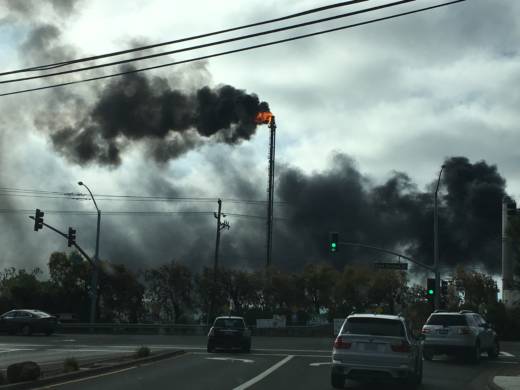The report says the sequence of events that led to the outage began May 4, with a transformer failure at a substation adjacent to the refinery.
The CPUC report says that the PG&E operator who detected the problem reviewed company diagrams and documents and concluded the transformer issue would not affect a safety system designed to protect the refinery if it's disconnected from the utility's electrical network.
The safety system is necessary because the refinery generates part of the electricity it needs from an on-site power plant. The system, known as "anti-islanding" protection, is designed to prevent electricity from flowing out of the refinery. The protection scheme is designed to kick in if both of the major PG&E transmission lines to the utility's Benicia substation suffer major problems or are taken offline simultaneously.
Early the morning of May 5, the CPUC report says, PG&E operators at the substation de-energized one of the transmission lines as the first step in a long-planned maintenance operation. Cutting power to the transmission line, along with the previously discovered transformer failure, activated the anti-islanding system. Power to the entire Valero facility went down.
The CPUC investigation incorporates findings from Exponent, an engineering firm PG&E hired to analyze the incident.
Exponent found that the PG&E operator who first noticed the transformer failure did not understand that it could play a part in triggering the anti-islanding system.
The engineering firm noted that the PG&E's document describing the system "is perceived by operators to be unclear on conditions necessary to activate the scheme, the instrumentation equipment ... that the scheme depends on" and other key information.
Exponent recommended a series of safety measures -- including improved training and maintenance procedures and the use of warning devices to alert operators of potential problems with the anti-islanding system -- to prevent future incidents.
The CPUC's investigation concluded that PG&E violated a state regulation that requires electrical substations to be operated and maintained safely and in a manner to provide adequate service.
In addition to failing to maintain the transformer involved in the incident, the CPUC said,"PG&E did not provide adequate training, documents, or diagrams for its operators to fully understand the anti-islanding protection scheme. If the ... substation operators had sufficient training and documentation on the anti-islanding protection scheme, they would have properly identified and resolved the failed (transformer issue) and prevented the incident from occurring."
On Wednesday, PG&E spokeswoman Deanna Contreras reiterated the company's earlier apologies for the outage, but said it does not agree withthe CPUC's findings. The utility has maintained the electrical failure was Valero's fault.
"PG&E denies the CPUC's specific allegations that we failed to maintain a type of transformer for its intended use and that we failed to provide adequate training, documents or diagrams to operators," Contreras said in an emailed statement. "Additionally, PG&E maintains that the responsibility for the unplanned refinery shutdown rests with Valero."
Two previous probes, by Solano County and state workplace regulators, cleared Valero of wrongdoing.
Contreras added that PG&E is adopting Exponent's safety recommendations.
Steven Weissman, a lecturer at UC Berkeley's Goldman School of Public Policy and a former CPUC administrative law judge, said the company should aggressively implement those measures.
"It's going to want to be responsive to this," Weissman said.
A Valero spokeswoman declined to comment on the CPUC report, citing its pending litigation.
But earlier this week, a Valero executive told the Benicia City Council that the refinery and PG&E are working out new rules aimed at preventing a repeat of the 2017 incident.
“We want to limit the number of times PG&E is sticking a screwdriver into the wires that supply our refinery,” Rich Walsh, vice president of Valero’s regulatory and environmental law programs, told council members on Tuesday.
The new protocols would require PG&E crews to consolidate their maintenance work on the electricity lines that serve the refinery into shorter time periods and allow Valero to inspect PG&E equipment before those jobs, among other changes.
Read the CPUC report here and below.
